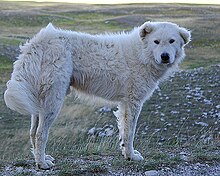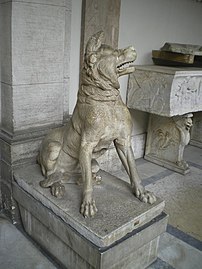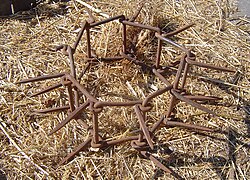
The Komondor, also known as the Hungarian sheepdog, is a large, white-coloured Hungarian breed of livestock guardian dog with a long, corded coat.
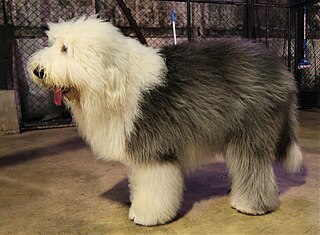
A sheep dog or sheepdog is generally a dog or breed of dogs historically used in connection with the raising of sheep. These may include livestock guardian or pastoral dogs used to guard sheep and other livestock in farms for farmers, and herding dogs used to herd sheep and other livestock.
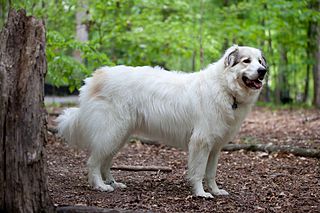
The Great Pyrenees, known as the Pyrenean Mountain Dog outside of North America, is a large breed of dog used as a livestock guardian dog. It should not be confused with the Pyrenean Mastiff.

A herding dog, also known as a stock dog, shepherd dog or working dog, is a type of dog that either has been trained in herding or belongs to breeds that are developed for herding.

The Bergamasco Shepherd is a breed of dog with its origins in the Italian Alps near Bergamo, where it was originally used as a herding dog.
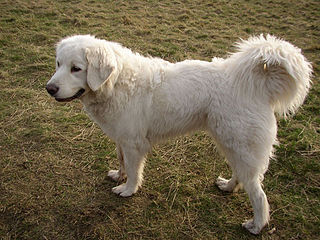
The Polish Tatra Sheepdog is a breed of dog introduced into the Tatra Mountains of Southern Poland by Vlachian (Romanian) shepherds.
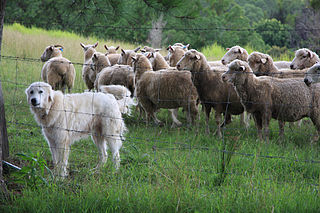
A livestock guardian dog (LGD) is a dog type bred for the purpose of protecting livestock from predators.
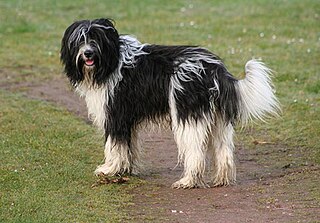
The Schapendoes or Dutch Sheepdog, is a breed of dog originating in the Netherlands. The Schapendoes was originally a herding dog and general farm dog, but today also participates in dog sports such as agility and flyball.
The Italian Shepherd, or Pastore Italiano, is a breed of dog. The existence of this breed can be traced back to 1975, when Piero Accettella, of the Little Ranch Kennels, in Cepagatti, in the province of Pescara, in Italy, noticed that, in the surrounding Italian regions of Abruzzo, Umbria, Tuscany, Marche and Northern Lazio, there existed mid-sized dogs with wolf-like features used as livestock herders and known locally as Cane Toccatore. Accettella acquired some of these dogs and crossbred them with Abruzzese Mastiffs, a breed of molosser, to increase their size. The result of this cross was a dog of great intelligence, wary of strangers and a tenacious guardian of property and livestock. The dogs have been found to be ideally suited to the role of guard dog and are easily trained for this task.
The Abruzzese Mastiff is a breed related to, but distinct from the Maremmano-Abruzzese from the Italian region of the Abruzzi. The Mastino Abruzzese represents the original Abruzzese strain and is characterized by its larger size, some male dogs reportedly exceeding 100 kg (220 lbs) in size. Some of these dogs have been successfully employed as livestock guardian dogs in the United States and in Norway, where reportedly they were effective in deterring predation by bears. Mastini are employed in packs of 4 to 10. The pack leader is the one who will engage predators in combat more often and usually wears a spiked iron collar to defend its throat.
The Sardinian Shepherd Dog or Fonni's Dog is an ancient landrace breed of Sardinian dog used as a herding, catching, and livestock guardian dog.
The Cane Toccatore is a dog used as a shepherd, similarly to the Border Collie.

The Cane Pastore Biellese is a mid-size yet powerful dog with plenty of stamina that is used in the Western Alps of Italy to drive flocks of sheep and herds of cattle. Though not recognized by the FCI, it has gained recognition in the Alianza Canina Latina.

The Italian Kennel Club, Italian: Ente Nazionale della Cinofilia Italiana, usually known as ENCI, is the national organisation responsible for dog pedigree registration services in Italy.
The Cane Lupino del Gigante, also known as Cane da Pastore dell'Appennino Reggiano or Cane Luvin, is a local variant of Cane Toccatore which has been used by shepherds on the Apennine Mountains near Reggio Emilia. Gigante Fernan refers to a mountain present in the area where the dogs live. The decline of sheep raising in the area led to a decline in the numbers of the breed, which is now reduced to about 200 specimens.

Cropping is the removal of part or all of the pinnae or auricles, the external visible flap of the ear and earhole, of an animal; it sometimes involves taping to make the ears pointy. Most commonly performed on dogs, it is an ancient practice that was once done for perceived health, practical or cosmetic reasons. In modern times, it is banned in many nations, but is still legal in a limited number of countries. Where permitted, it is seen only in certain breeds of dog such as the Pit bull, Miniature Pinscher, German Pinscher, Doberman Pinscher, Schnauzer, Great Dane, Boxer, Griffon Bruxellois, Briard, Bouvier des Flandres, Neapolitan Mastiff, Cane Corso, Cão Fila de São Miguel, Perro de Presa Canario, Dogo Argentino, Caucasian Shepherd Dog, Central Asian Shepherd Dog and Beauceron.
The Cão de Gado Transmontano is a giant dog breed of molosser type, and primarily a working dog used as a livestock guardian. Originating in the region of Trás-os-Montes e Alto Douro Province, Portugal, it is a rare breed mostly confined to this area. Their primary function is flock and herd protection, and their success is interlinked with the welfare of the flock and the presence of wolves, particularly. Although they are a regional breed, their wolf-defense capacity has led to limited experimental importation elsewhere. The FCI officially refers to them as Transmontano Mastiffs and some Portuguese breed clubs that provide translated webpages in English have also referred to them as Transmontano cattle dogs.
Abruzzo Sheepdog may refer to two closely related breeds of sheep dog widely used and likely originating in Abruzzo, Italy:

The Pastore della Lessinia e del Lagorai is an old Italian dog breed from the northeastern region called Triveneto. It is not recognized by any major kennel organisation.
